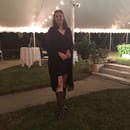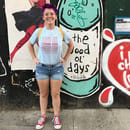Like many people, I spent the first 15 years of my life, roughly, as a very creative individual… or at least, I thought so, and at that point no one else’s opinion mattered. In my preschool and kindergarten years, I drew many pictures, often multicolored scribbles of shapes vaguely resembling humanoid in even more colorful settings of trees and rainbows floating on white paper skies.
As I grew older and learned to color within lines and how to mimic those lines in my own art, I also learned to read and write, and eventually, I drifted away from drawing and fingerpainting and started writing for myself. When I was about 12 or 13, I started a novel. I had 2-4 main characters and roughly 10 supporting characters, a setting, a plot, a beginning, an ending, and two chapters before I quit. I lost faith in myself and in my writing for a little while, and then I got caught up in high school and essays.
Slowly, I started getting ideas for more novels and books and stories, and I started keeping a notebook of these ideas. Now I’m in college and I’ve actually started writing again. Part of this is due to the use of some exercises introduced to me by friends and professors. Whether you create visual art or find your joy and frustration in writing, I hope you find these useful.
Set a timer.
Whether it’s for an hour, 30 minutes, or 5 minutes, set a timer and just work. Write without stopping to edit, make your art, whatever it is, without stopping to correct mistakes or stray brushstrokes. Just work.
Work within a form.
If you’re drawing or painting, restrict yourself to certain shapes or colors and build new images with those. If you’re writing, work within a form, such as a sonnet or other form of poetry, or use a theme of certain images to make new meaning. There are lots of ways to limit your writing that simultaneously opens new creative choices.
Use whatever is in front of you.
I started a short story based on having one line of a country song stuck in my head, and I started another story about two bags of chips fighting in heaven because I looked at the vending machine. Use stuff from real life that you see or experience on a regular basis. Use random stuff like bags of chips or day-old coffee. You can use literally anything as inspiration.
Make lists.
Make a list of things that has one thing in common, or many things in common, but are not directly related. For example, I made a list of things that I believed in as a child and wrote about which ones I still do believe in, and which ones I don’t, and why. I drew a charcoal picture of everything I could see on my dresser top. Lists aren’t just for shopping and chores.
No matter what art you are creating — drawing, painting, sculpting, writing, composing, whatever — try these strategies out. You may be surprised at what you get out of it.



